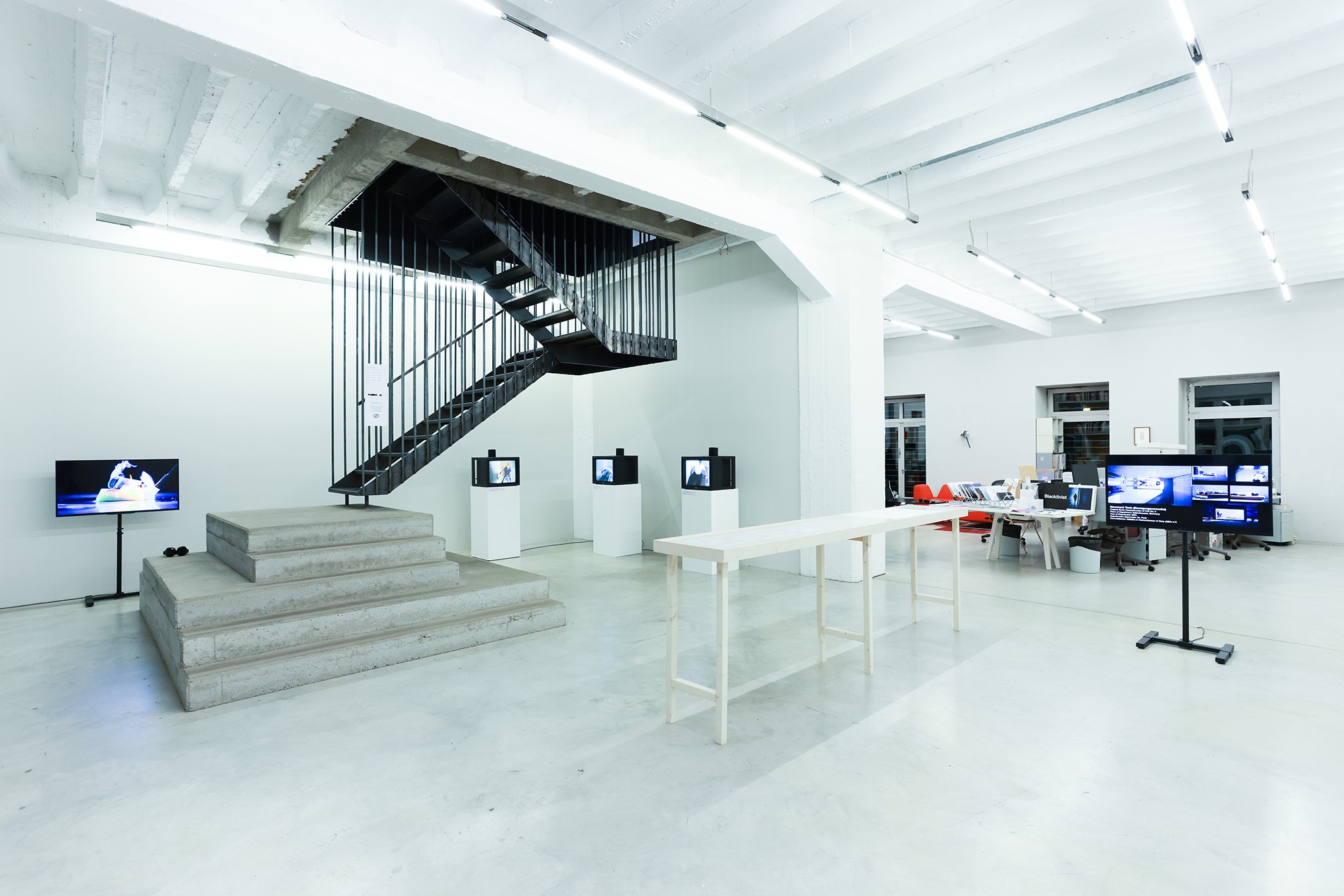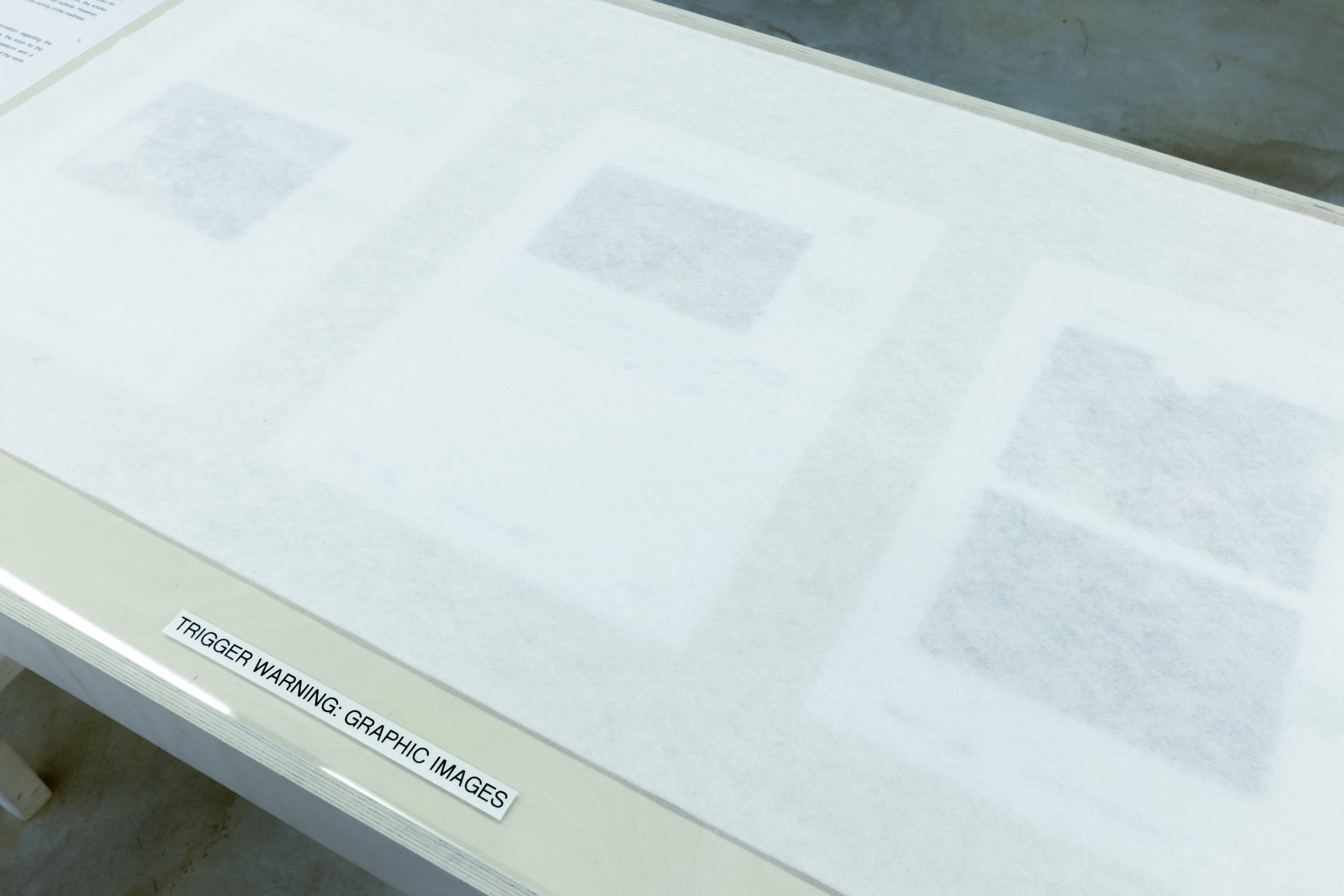Installation View: KOW, Berlin, Germany
Pfeifer’s film exposes him—him and many others too. It does not purport to know the truth. But its forty-three minutes of investigative cinema give a whiff of it, and if it is not the truth itself that is laid before us, it is all the efforts that have been made to exclude it, to make it impossible. This is not easy to digest. Pfeifer shows original police footage, videos from the scene of the crime, and disgraceful fire tests run by unqualified state “experts,” along with accounts given by friends and relatives. He introduces us to the case and takes us through it: his aesthetics are cool-headed and entirely matter of fact, making no attempt to create an impact or an emotional response. Quite the reverse. To get an idea of Pfeifer’s artistic approach, all you need do is watch Netflix documentaries. What he does is the opposite of this, though his work, it should be said, is no less exciting for that. Here, the excitement is of another kind entirely. Pfeifer’s reconstruction of events is not an entertaining story to enjoy from the comfort of the sofa: this is the most scandalous case of institutional racism in modern-day Germany, which sees civil society at odds with a state governed by the rule of law, truth pitted against lies, and transparency and responsibility coming up against closed ranks and walls of silence.
This is where Iain Peck enters the fray. The renowned British forensic scientist was commissioned by the “Initiative in Gedenken an Oury Jalloh” to evaluate prior reports by state experts. His opinion was not very positive. None of the inquiries ordered by the court were able to explain how the body and the room could have been burnt in the way that they were. Pfeifer’s production gives Peck the opportunity to draw up his own expert opinion in an exact replica of Cell 5 (this was shown at KOW in 2021 before being moved on location). In producing his report, Peck did something that the German justice system considered “unthinkable”: he used fire accelerants—with the implication that this was an act of murder. The result of this was that it was possible for the first time to accurately reconstruct the way the fire developed at the original scale.
Pfeifer’s exhibition at KOW presents video footage of police tests alongside the film installation, as well as an original copy of Peck’s report detailing his own studies. You can find a recording of the press conference at KOW on November 3, 2021, on our webpage.
Text: Alexander Koch
Translation: Simon Cowper
PROOF OF THE UNTHINKABLE
© 2022
It is a detailed depiction of death by fire. A film that serves as evidence. It examines a scandal that has preoccupied Germans for he last seventeen years—the Oury Jalloh case—and takes it to the next level. This is one of a number of unsolved cases involving the cover-up of the murder of a black man by the police. Flying in the face of justice and
humanitarianism, the German state glossed over this putatively racist act.
Mario Pfeifer’s film installation Cell 5: A Reconstruction sets out new dev lopments in the case. Pfeifer’s project established the framework for a new orensic report on the fire to be produced on behalf of the “Initiative in Gedenken an Oury Jalloh” (Initiative in Remembrance of Oury Jalloh). Its findings debunked the previous judgment, and the case was passed to the Public Prosecutor General following a press conference at KOW on November 3, 2021. Not only that but Pfeifer’s film also shows images of events surrounding the fire for the first time, providing audiences with an intelligible account of what happened on January 7, 2005. The upshot of this is that there will, inevitably, be mounting pressure coming from the public and politicians for the Oury Jalloh case to be cleared up at long last.
The fire at the police station in Dessau-Roßlau burned for thirty minutes: temperatures in the tiny holding cell no. 5 are thought to have reached 800degrees before firefighters arrived on the scene. Over the years, various fire investigations and court proceedings have failed to explain how Jalloh could have died in this way. If the “Initiative in Gedenken an Oury Jalloh” had not constantly pressed—with the support of donors and journalists—for new expert reports and legal proceedings, the case would no doubt have been filed away long ago. But this has not been allowed to happen. Pfeifer’s film revisits events once again, giving the case renewed legal and public relevance.
The film starts out by presenting the protagonists involved: police officers from Dessau-Roßlau, investigators, expert consultants responsible for previous reports, forensic scientists. Their statements, which have gone on record, are repeated by members of the public, and the contradictions—lies?—that have dogged the case over time are summed up. There is one question at the heart of it all: Did Oury Jalloh set himself on fire in Cell 5 (as per the official version of events)? Or would that have been impossible? If he didn’t, he must have been murdered. And if he was murdered, it can only have been by the police. The Dessau district attorney, who is quoted as saying that this “is virtually unthinkable,” evidently did everything he could to prevent the unthinkable from being thought and becoming fact.
Installation Views: KOW, Berlin., 2022
Public Program at KOW, Berlin
October 29, 2022 5 p.m. – In Conversation
Forensic Iain Peck, members of the Initiative in Remembrance of Oury Jalloh e.V. and Mario Pfeifer
November 05, 2022 5 p.m. – In Conversation
Bea Streicher (Amnesty International in Germany and Mouctar Bah (co-founder of the Initiative in Remembrance of Oury Jalloh e.V.
Installation View: Grids of Violence – From Gazes to Acts, Stadtmuseum Dresden | Kunsthaus Dresden, 2023
Selected Press
DW radio | Inside Europe “What really happened in Cell5?
Benjamin Brathke
Wer vertraut der Polizei? – gallerytalk.net
Lynn Kühl, 09/2022
Spurensuche im Fall Jalloh – FAZ
Georg Imdahl, 11/2021
Ein Mensch brennt – taz
Jan-Paul Koopmann, 03/2021
Sichtbar bleiben – NWZ
Oliver Schulz, 03/2021
Exhibitions
KOW, Berlin , GER| 2022
Kunsthalle Winterthur, CH | 2023
Bundeskunsthalle Bonn, GER | 2023
Kunsthaus | Stadtmuseum Dresden | 2023



























